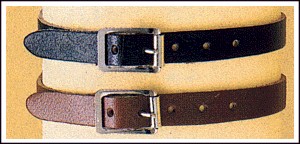Cavalry Spurs
The tradition has its roots in knighthood, where the awarding of gilt spurs symbolized entry into the ranks and fraternity of mounted warriors. Usually, the squire aspiring to knighthood had to perform some task or deed on the battlefield or tournament field (tournaments were considered like our training maneuvers) to "win their spurs." The spurs themselves were buckled on during the investiture to knighthood, usually during Mass or some other religious ceremony; knighthood, itself, was considered sacramental, if not a sacrament itself. Thereafter, it was the spurs that symbolized that a man was a knight--not his sword, horse, or armor. No matter how financially destitute, a poor knight would part with everything else before his spurs. The primary act of degradation (removing someone from the knightly class) was to have another knight cut off the offending knights spurs. So much for the mists of time; it is not known, exactly, when the tradition of awarding spurs was started it in the U.S. Cavalry. | ||||
Silver Spurs vs. Golden SpursSince Gulf War II and the War on Terror, the Army I knew has changed. Back in the day, the only Spurs awarded were Silver Spurs. Now, some Cavalry units award Golden Spurs for combat duty in the Theaters of Afghanistan and Iraq. And, this webpage does not address either qualifications or awarding of Golden Spurs. I can best describe the difference between Silver and Golden Spurs by using the Army's Expert Infantry Badge [EIB] and its counterpart, the Combat Infantry Badge [CIB]. In the US Army Infantry, a prized award is either an EIB
or CIB. And, I do not have either award. The EIB is earned through an
exhaustive competition. And, the CIB is earned by being assigned to an
Infantry unit below Brigade level in the combat theater. And, Silver and
Golden Spurs are similarly awarded. However, | ||||
1. The Order of the Spur recognizes an individual's accomplishments while assigned to a cavalry unit. The privilege of being awarded spurs in 7th U.S. Cavalry comes with hard work. 2. The following minimum guidelines must be met:
3. Qualified on a Squadron Spur Ride. The title belies the nature of this event. A Spur Ride is led by "Spur Qualified" Non-commissioned Officers and is supervised by the Squadron Command Sergeant Major. Officers, generally, conduct their own Spur Ride along similar lines. Traditionally, it starts at the break of day with group PT or a PT test; individuals and their equipment are inspected, and a thorough hazing of candidates begins. During the course of the day, candidates are subjected to different stations that test their initiative, military expertise, and stamina. As night approaches, the candidates are assembled and provided with instructions. From there, the candidates must negotiate a general route from station to station where, again, their skills and tenacity are tested. Their route is designed to take them over a twenty-five mile course in the dead of night. During the course of the night and usually into the morning, candidates negotiate the course and, eventually, arrive at the finish line. Even though the Spur Ride that I completed at Ft. Hood in 1994 did not result in death or many serious injuries, there have been times where other troopers weren't so lucky. Old soldiers tell stories, and here are two of my favorite stories about Spur Rides. During the 1960's in Baumholder FRG, the candidates were not informed of the boundaries and restrictions. Some enterprising candidates hitch-hiked on German roads and finished ten hours ahead of others. Of course they were "No Go's." Also, candidates became disoriented upon returning to the Baumholder Kaserne and wound up moving through the housing area, attempting to go "straight-line" and reduce the distance traveled. Some were shot at and some were shot. Not good. Also in Germany in the 1960's. Command Sergeant Major Cook (1-7 Cav, 1995-1996) told me that, during his Spur Ride, his group was inserted into a remote forest region and were to negotiate a three-day course. During the first day, a fellow candidate fell and broke his leg. The other candidates in the group fashioned a litter and carried the soldier for the remaining two days. All of them completed the course in an appropriate time, and all were awarded spurs, including the soldier with the broken leg. 4. In addition to the above minimum requirements, the following are criteria that will be graded on a point system. A total of 300 out of a maximum of 450 will qualify.
5. The Squadron Commander will then award the Spurs to be worn proudly during the "Troopers Cavalry Career."
| ||||
In the 1st Squadron, 7th Cavalry, spurs are awarded and the Squadron Commander signs a Spur Certificate. (Interestingly, this certificate is not recognized by III Corp and is not accepted for inclusion in your 201 File.) This certificate states:
Current periods of "Spur" Program activity:
| ||||
|
Spurs consist of two distinct items and are available from several vendors online.
| ||||
Fiddler's Green | ||||
Home |

